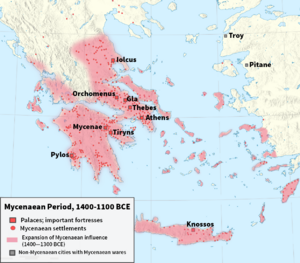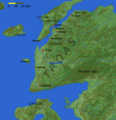Historicity of the Iliad facts for kids
| This article contains special characters. Without proper rendering support, you may see question marks, boxes, or other symbols. |
The historicity of the Iliad asks a big question: Was the famous Trojan War a real event, or just a made-up story? For a long time, people thought it was just a fable. But then, amazing discoveries changed everything.
In the 1870s, an archaeologist named Heinrich Schliemann started digging at a place called Hisarlik in modern-day Turkey. He believed this was the ancient city of Troy. What he found made many people wonder if the Trojan War really happened. Later, archaeologists found a city layer called Troy VIIa. They also found ancient writings from the Hittites that mentioned a place called "Wilusa" which sounds a lot like "Ilios," another name for Troy.
These discoveries suggest that the Trojan War might have been based on a real conflict around the 12th century BC. Even if the poems by Homer (like the Iliad) changed some details over hundreds of years, there could be a historical truth behind them.
Contents
Was the Trojan War Real?
Ancient Beliefs About Troy
Long ago, in Ancient Greece, most people believed the Trojan War was a true story. They might argue about small details, but they thought the main event was real. For example, the historian Herodotus thought Homer had made some parts bigger than they were.
The Roman empire also saw the Trojan War as a historical event. Even in the Middle Ages, people in Europe believed it was real. Many royal families even claimed they were related to the heroes of Troy!
Modern Discoveries at Troy
Over time, people became more doubtful. They thought the Trojan War was just a "romance" or a made-up tale. But then, Heinrich Schliemann started his digs at Hisarlik. This site was known as Classical Ilion, where ancient people thought the war happened.
Schliemann found many layers of old cities buried there. He thought one of them was the Troy from Homer's stories. Later digs showed that his chosen city was too old to be the Troy of the Mycenaean era. However, archaeologists kept digging. They found other layers from the Late Bronze Age, which was the time of the Mycenaeans.
Today, experts are still debating if the Trojan War was real. Some think we can never truly know. Others believe there are clues that point to a real event.
What the Iliad Tells Us
The Iliad focuses on the feelings and actions of the warriors, not on war strategies. It assumes everyone already knows the story of the Trojan War. No one today believes that all the events in the Iliad are true, especially the parts with gods interfering! But many think the story holds some memories of the Mycenaean Age.
The Iliad as a Legend
Some experts, like Moses I. Finley, believed that none of Homer's stories were truly historical. They thought the Iliad was a collection of made-up tales from start to finish. Finley pointed out that a ten-year war seemed unlikely. He also noted that Homer's descriptions of armor and chariots didn't quite match what archaeologists found from the Mycenaean Age. For example, Homer's heroes drove chariots to the battle, then got out and fought on foot. This isn't how chariots were used in real ancient warfare.
Finley believed that the poet was singing about a heroic past that was part of his own Greek world, not a perfect memory of the Mycenaean Age. Some scholars suggest that the Homeric stories are a mix of many old Greek tales about different sieges and battles from the Bronze Age. These stories might have been combined during the "Dark Ages" after the Mycenaean civilization ended.
It's also interesting to compare the Iliad to older stories from Mesopotamia, like the Epic of Gilgamesh. Some names and parts of the stories are very similar. This might mean that early Greek writers were influenced by these older poems.
The Iliad as Partly Historical
Most experts today think the Iliad probably contains a mix of historical facts and made-up stories. Homer describes a city near Mount Ida in northwest Turkey. A city like this, Hisarlik, did exist in the Bronze Age.
Clues from Hittite Writings
Ancient Hittite texts give us some interesting clues. They show that Late Bronze Age Troy was an important city in its region. It was also known by names similar to its later Greek names. The Hittites also had political dealings with the Mycenaean Greeks.
The Hittite names Wilusa and Taruisa are often thought to be the same as the Greek names (W)ilios and Troia. These names were first linked because they sounded similar. Now, we also have geographical evidence. Hittite texts place Wilusa in the Troad region, where Hisarlik is the only major Bronze Age city found.
Some Hittite documents talk about problems in Western Anatolia that affected Wilusa. For example, letters mention a warlord named Piyamaradu who was supported by the Ahhiyawa (who might be the Achaeans, or Greeks). These events have sometimes been seen as a possible real-life basis for the Trojan War. However, experts say that the texts don't give clear proof of a war. They mostly show political disagreements, not a huge conflict.
Clues from Homer's Descriptions
The Catalogue of Ships in the Iliad lists many cities. Some of these cities, like Athens, were lived in during both the Bronze Age and Homer's time. But others, like Pylos, were not rebuilt after the Bronze Age. This suggests that the names of these old, ruined towns were remembered from a much older time. It's unlikely Homer would have known about them otherwise. The list also groups cities by their location, showing good knowledge of the Aegean area.
Clues from Mycenaean Tablets
In Mycenaean Greek writings called Linear B tablets, some names from Homer's poems appear. For example, the name Achilles (written as a-ki-re-u) is found on tablets from Knossos and Pylos. The Achilles on the tablet was a shepherd, not a king or warrior. But the fact that the name is a real Bronze Age name is important. It suggests that the names in Homer's poems remember an older time.
Clues from Geology
In 2001, a geologist named John C. Kraft studied the land around Troy. He compared the current landscape with descriptions in the Iliad and other ancient writings. He found that the location of Troy at Hisarlik, the Greek camp, and the battle descriptions in the Iliad often matched the geological evidence. This suggests that the story's setting was based on a real place.
Images for kids
-
Map of Bronze Age Greece as described in Homer's Iliad.
See also




